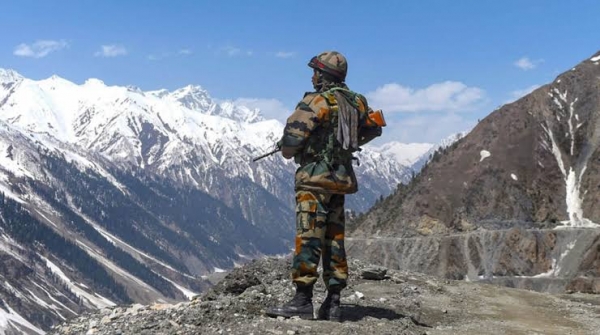Confrontational border dispute between India and China at the Galwan valley brought back the memories of the 1962 war in the minds of many Indians. There are many interpretations of the actual series of events which actually boiled down in that disputed border area. It gives rise to many narratives of the issue. To understand the issue regarding the LAC- line of actual control, in the Ladakh region, one must first know what exactly it is. It is basically a type of demarcation line which is a kind of border in the geopolitical sense which is agreed upon by the neighbours after ceasefire or armistice.
It cannot be explicitly called a border but a disputed area of the land as its territorial interpretations differ between the different countries. Galwan river valley and Depsang comprise the northern section, the Pangong tso lake and Chusul form the central part and the Demchok and Chumar forms the souther section of the Line of actual control- LAC. There were reports as of on April 19 that there were troop movements on the Chinese side. How these reports were read and analysed and communicated on the ground becomes a matter of varying interpretations by different narrators. Due to the Covid19 pandemic, the operations to monitor the border area were called off. Then came the reports of LAC violations by the Chinese troops in the Galwan valley and at the Hot spring on May 5th, in the Chushul area in mid-May, near the Pangong lake on May 17, in Daulat beg oldi at Depsang in the second week of June. Almost 2000 kn away at the Naku La pass, another border violation was reported on May 9th. So this was a five finger attack by the People’s liberation Army of China.
Scuffling with Indian soldiers, many PLA troops entered into the Galwan valley making their way into the junction of Galwan river with the Shyok river. This point is strategically crucial as it gives the occupying troops advantageous vantage viewpoint over the DSDBO road- the Darbuk-Shyok-Daulat Beg Oldi Road. This road is a recently built road to the northern Ladakh. It forms an important link for the army to the SSN region- the subsector north region. This road has the same level of relevance in this region as the Srinagar-Zojila-kargil-leh highway has in the context of the Kargil issue. Regarding the ingress at Gogra and the Hot Springs, there are differing accounts regarding the shifting of the LAC line westwards. Some report that the Chinese troops had intruded deep into the Indian side at the Hot Springs and Gogra and the confrontation has continued there longer than what is being claimed by official reports. There were concerning reports that at the Galwan, Chushul, and Pangong Tso after the incursions, the Chinese had built fortifications with clear intentions to stay in the Indian Territory. It was all the more worrisome that the regional Chinese troops’ commanders were not responding to the Indian calls for flag meetings under the BMP-‘Border management posture’ which guide the patrolling routines in the regions for troops of both the sides.
What concerns most is the presence of signs of serious intelligence and/ or operational failures, otherwise such ingression would not have occurred at the first place. This issue has its origin in the confusing nature of a de-facto border which is neither demarcated or marked on the ground at the site nor delineated or discussed and settled on a common reference map. There have been five major measures taken since the early 1990s in terms of maintaining peace in these regions. The first one was the BPTA- border peace and tranquillity agreement signed in 1993, another involved confidence building measures (1996), an agreement on defining the standard operating procedures (SOPs) and the latest one being the Border defence cooperation Agreement (2013). A window of hope was defined in the agreement of 1996 where the common understanding of the LAC was stressed as a primary need for peace in the region. But, Beijing refused to coordinate on any map sharing for the region keeping the region alive as a bone of contention. As per the aforementioned BPTA- border peace and tranquillity agreement, every year in the month of October, generally on the 30th day, India and China carry out the border personnel meeting – BPM which gives a chance to revise and update one another about scenario on the ground and revive cross border confidence. Was this meeting underutilised in 2019?
China has an ambition of turning the South-China Sea into a new middle-east by digging up Oil and Gas from the region. This is not unknown to the world. It gives China a leverage to pose as a strong regional player in South Asia. Hence, it will look for opportunity to pose as one wherever possible. Some reports coming from Chinese media point out that the abrogation of the article 370 by India, forced China to flex its way into Ladakh. That can be a hogwash, given the long-term Chinese fetish to show geopolitical and military muscle, so much so that an all-out war did not seem like a remote possibility in mid-May.
In this confrontation issue, India lost 20 of its brave soldiers under the leadership of Col Santosh Babu. Local hospital reports say that they had multiple fractures and stab wounds on their bodies and that they were fighting even on being outnumbered. This indicates that the misadventure from the Chinese side was no mere skirmish but a full-fledged attempt to get into Indian territory. Paying homages & tributes will not suffice; nor will blaming the Nehruvian regime for the current border scenario help in solving the issue. Presenting the real picture in this contentious border region to the world and using the BPM meeting mechanism this year in October to iron out the issues should be the priority. Recent disengagement talks between India and China under the Working mechanism by consultation and coordination on border affairs opens up the road to an amicable solution for the Ladakh region.





